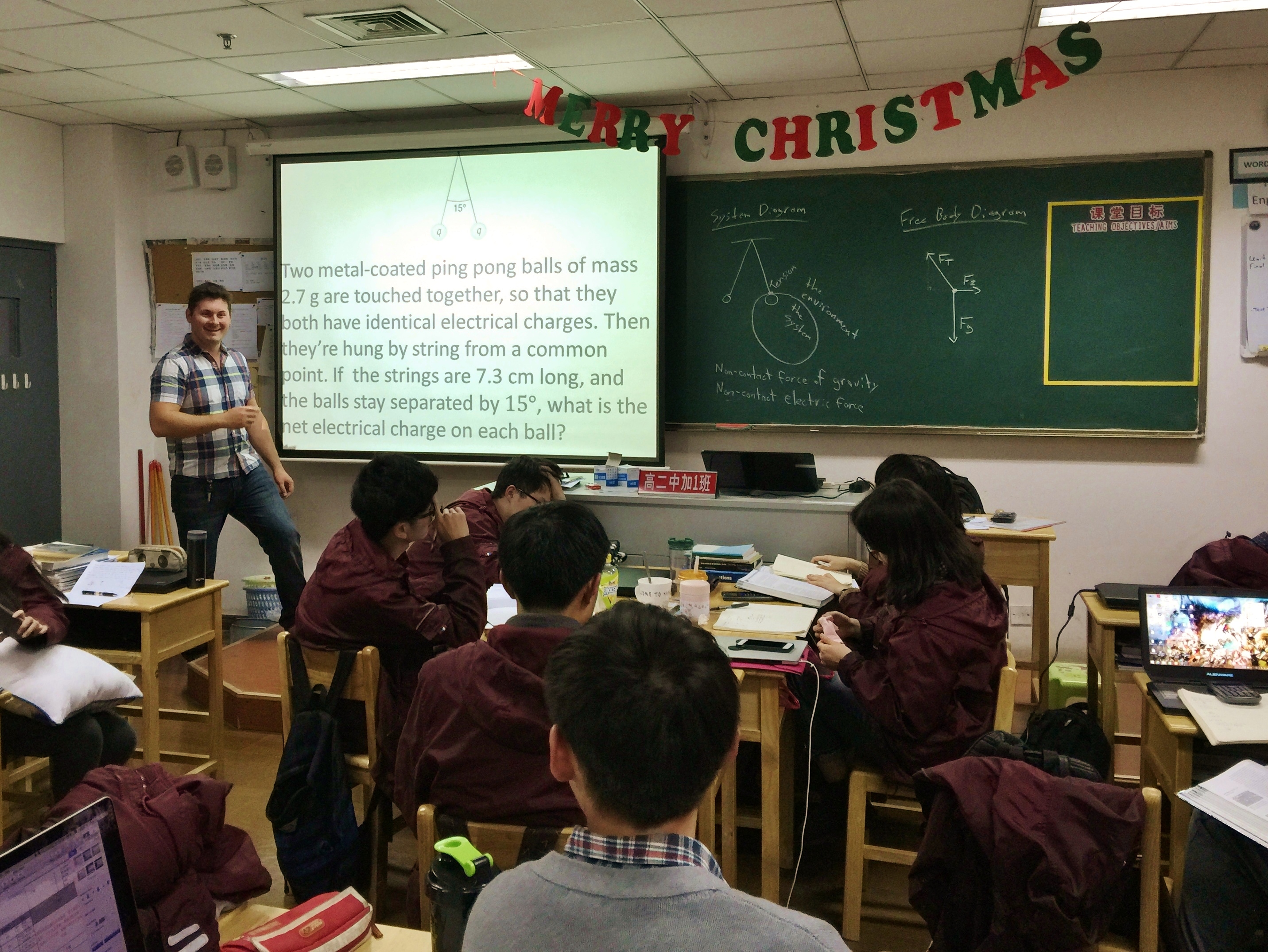Eric Haller, Bond Schools InternationalWhy I came to China
My name is Eric Haller, and I’ve been teaching students the Ontario physics curriculum in Nanjing, Jiangsu, China for two and a half years now. If you asked me when I was in teacher’s college, “where will you be teaching next year”, I would never have answered it with “China”, yet here I am. The lack of jobs in Ontario (even for us physics teachers) is a major deterrent for staying in Canada. The offer of full-time work abroad, my own classes of students, and a lower cost of living were all enough to convince me to come here. If any of you are interested in going abroad like me, especially new teachers, then I’d like to take this chance to tell you a little bit about some of my own experiences that I’ve had during my time here.
Getting Hired
I was offered an interview from Bond Schools International; they were actively looking for teachers and emailed me because I was in the applytoeducation.com data base. Often schools that are abroad are short teachers, and have to put in lots of effort to find them. During my interview with Bond, it became strangely obvious that the interview was double sided; I needed to convince them that they wanted me to teach for them, and they needed to convince me that I wanted to travel to China to teach for them. I guess we were both successful.
If you’re looking to teach Ontario’s high school curriculum in China, the biggest employers you would want to look into are
Maple Leaf Schools, and
Bond Schools International. The Ontario Ministry of Education’s webpage on
certified overseas schools lists more schools you could apply. Most schools overseas will offer one or two-year contracts, housing, a round-trip flight, and assistance in getting your work visa.
Day-to-day Life in China
Before I get into my experiences teaching physics in China, I’d first like to mention some of my day-to-day experiences over here. China is literally a world away from home, the time-zone difference is usually twelve hours off (thirteen sometimes because China doesn’t do daylight savings) which makes it difficult to stay in touch with people back home. Also, my phone can’t call outside of China, and Facebook and Gmail have been blocked by the government, along with about half of the internet. This makes it difficult to stay in touch with friends. Virtual proxy networks (VPNs) like Astrill help with that significantly, but I recommend also bringing things from home to cope with being away from Canada; I have a stuffed polar bear on my desk, and a moose that dances. Bring things like clothes and antiperspirant too, even foreign stores like American Eagle and H&M don’t carry my size here. Shopping actually isn’t that easy in China for foreigners. There are no dollar stores, and CDs and DVDs are typically bought off the back of someone’s scooter, as the stores don’t carry them. What is available in stores isn’t exactly what you’re going to be looking for. Here’s the selection of dried ducks and pigs’ faces available at Walmart:


And my local grocery store has a fine selection of fish heads:


Also, online shopping is extremely popular, which makes it even harder to find things in stores. The big online store, taobao.com, doesn’t have an English setting, and is not very foreigner-friendly. The address needs to be in Chinese writing, and you often have to talk with the seller or the delivery person in Chinese. It’s hard to pay on those websites as well because I don’t have a Chinese credit card, just debit.
Many of the things that are available in China have been modified, fake purses and watches are everywhere, and I’m even suspicious that my Colgate toothpaste is not actually made by Colgate. Hollywood movies are also modified for China; sometimes screenwriters go out of their way to include scenes in China to make more money from the Chinese market (Transformers 4), or the Chinese Film Bureau will remove bonus scenes after the credits (many of the Marvel movies). Even movie posters are modified for the Chinese market. Here’s the North American Star Wars Episode VII movie poster you’re used to:


And here’s me in front of the Chinese movie poster:

You may have noticed Finn (a black character) has been shrunk, Chewbacca (a wookie) has been completely removed, and a significantly larger army has been added. After such modifications, some movies come here late (Star Wars just came out January 9th), and some movies never come at all (Episode VII is the first Star Wars film to ever come to China, and The Hunger Games 3 part 1 was banned the night before its release, yet its part 2 was released the same day as it was in Canada).
The School
Now let’s get to my experiences in China in my actual school. The Ontario program at my school is a very small part of a very large private school. There are British, Australian, and Prince Edward Island programs here as well, but most of the students in our school study a normal Chinese curriculum. I’m the only foreign physics teacher in the entire school at the moment. The isolation from other physics teachers is nice because it gives me a lot of freedom in how I teach, although, it has its disadvantages too. It is hard to bounce ideas off of others, and I can’t share and use other teachers’ tests, lesson materials or resources. Getting equipment for labs is also tricky; they don’t give out the keys to the lab rooms, and the lab technician who rents out the equipment doesn’t speak English. The lab doesn’t really have much equipment that I could use anyway. When I do a lab or demonstration I have to go to the stores and see what I can find, but this is done out of pocket and it takes a long time to find what I need in from the stores.
Teaching Physics in a Chinese Classroom
China’s education system and our own are very different. The students at my school have been educated with a heavy focus on memorization, and most of the lessons have been the classic chalk-and-talk setup, where a teacher writes things on the board and talks, and the students listen and copy what’s on the chalkboard. The assessments consist of a lot of standardized tests, not many teachers seem to create their own assessments from scratch. Some of the teachers use microphones and speakers when talking to their classes, as it helps enforce the authority that the teacher has, and it helps them to talk over the students who all too often won’t quiet down.
The students are at the school for most of the day, beginning classes at 07:30 and ending at 17:30. There is a two hour lunch period, which they spend eating and napping. Since the school day is so long, most learning is done in class, and homework is not emphasized as much. Also, the students studying the normal Chinese curriculum at my school are only expected to do four labs throughout all of their science courses, doing one each year. My students are not used to interacting in a hands-on way with equipment, and getting them to stay focused when working in groups takes a lot of effort. All of this, combined with the language barrier, makes it hard to explain things; and because they’re so used to lecture style teaching, it really makes it difficult to do non-lecture styled lessons. I have tried many different strategies I’ve learned from my time with the OAPT, some have worked and some have not. Here’s a brief summary of how some of those strategies have gone over with my students.

 Think-Pair-Share
Think-Pair-Share
The way think-pair-share works normally is you first give the students a question. The students think quietly about the question themselves for a minute, then turn to their neighbour and take turns explaining their own solution, and then listening to the other’s solution. I have tried this a few times, but I’ve found it impossible to do. My students immediately turn to their neighbours and try to figure out what the question is asking, explaining everything in Chinese while they do so. From there, since they’re already talking, they’ll start working on the problem together, not taking a minute to think about it on their own. I go around the classroom hoping to overhear what some of them are thinking, but none of it’s in English so I can’t learn much from it. After the time is up, I may ask one of the pairs for an explanation, but they have a tough time explaining their solution in English, if they even came up with one.
ABCDEFT clicker cards
In absence of having real clickers, where students press a button and a computer records their responses, you can print off the letters ABCDEFT onto cards and then ask multiple choice or true/false questions. After giving students enough time to think of the answer, the students all hold up their cards and show the teacher which answer they think is correct. With my students it takes them a long time to think of an answer, and again they will talk to their neighbours, and shout across the room to talk to others as well. After, when I ask them to show me their cards, most students have the same answer because they overheard other people’s conversations. The students who weren’t paying attention either don’t hold up a card, as they feel having no answer makes you look smarter than having a wrong answer, or try to copy everyone else’s cards. Rather than finding out who understands how to solve the question, I get an unrepresentative poll of answers. It’s hard to give useful feedback based on the biased results in the poll, which unfortunately defeats the purpose of using clicker cards in the first place.
White Boards
I’ve tried getting the students to write out their solutions to questions throughout the lesson by writing on a personal sized white board, with groups of 3 or 4 students. I’ll give everyone a marker, but I find the students are reluctant to work on problems in such an open way. Many are too shy, and I’ve had many instances where groups literally put nothing down at all. When I ask specific groups to share their work with the rest of the class, they often feel embarrassed by what they did and don’t like the attention that comes with sharing their rough work with others.
Self-Edited Quizzes
I give out short quizzes, and after they’re done I tell them to put their pencils away. Then I give them a red marker, as well as the solutions to the quiz. With the correct answers in hand, I ask them to make corrections to their own quiz in red ink. When I mark them after, I give them a mark out of how they originally did on the quiz, and a small mark based on how well they fixed their mistakes in red. This actually works out well. The students get immediate feedback, and get the chance to practice some self-reflection. Sometimes I do catch one or two people trying to cheat by using pencils and not the red markers for their corrections, but for the most part they don’t. Since their self-editing is counted for a mark, and they don’t have to let anyone else see their work, I find all the students actually complete it.
Chris Meyer’s Reformed Physics Teaching Student Workbooks
Chris Meyer has used his knowledge of Physics Education Research to create excellent workbooks for both grade 11 and 12 university level physics, which can be found
here. I wasn’t able to use most of the workbooks as I did not have a proper physics lab or much equipment, but I decided to go on taobao and order a class set of simple electronic circuits (batteries, light bulbs, switches, ammeters, ohmmeters, voltmeters, etc.) to try out the workbooks for the grade 11 electromagnetism unit. The students responded well to actually being hands-on with circuits, of course sometimes they did get off task and started playing with them rather than following instructions. I had to go a little slower with my students because they are still becoming accustomed to reading and following instructions in English; with a little extra time they managed it though.
The workbooks are designed to be completed in groups of three, with a recorder, a manager and a speaker, all working together. Assigning tasks to each member and getting them to follow roles was difficult. Often the strongest student in each group often tried to do all three parts; remember, explaining instructions for them to follow isn’t easy. Seeing the students learn on their own was rewarding though, they comprehended the material quite well. The students were able to build their own DC motors, and they performed well on the unit test. Having a workbook to follow helped organise their thoughts and notes, and it gave me lots of time to go around to the groups and probe their understanding with questions, however I did spend a lot of that time explaining what the students needed to do.
Another tricky part I found was explaining why the values we measured in experiment didn’t exactly fit the theoretical models. For example two identical bulbs may not have lit up identically in experiment, and measuring electric current through a wire before a branch would have a small error compared to the sum of the currents in both of the wires afterwards. Next time I’ll need to teach them more about errors in measurements first, or better yet, I think I’ll try to use computer programs to build simple circuits instead so I can completely avoid measurement errors. An excellent applet for circuits that I could have used instead is
available from PhET.
Labs
The labs I’ve been doing with the students have generally been going well too. I require a full write-up, which includes a hypothesis, list of materials, analysis, conclusion, and brief discussion of errors. Since the students can work at their own pace, they feel less pressure, and feel a lot more comfortable learning in this way; albeit the gathering of data is often done very slowly, but at a pace where even the slowest members of each group can keep up. The students talk a lot typically, which is actually a bonus when doing labs. After they finish collecting data in a period or two, I give them a weekend to work on it and they can usually give me a decent product by Monday. Plagiarism was a major problem at first. After the first lab I had to emphasize to them that they can have the same data, but everything else should be their own. When some students tried to plagiarise again on the second lab, I did a side-by-side comparison and showed the class how badly some of them copied each other. Here’s an example:


After this public shaming, plagiarism wasn’t a problem.
In summary
If you’re considering coming to China to teach physics, I recommend you give it a try. It is much easier to get a full time job here, the cost of living is low, and you’ll get great teaching experience. Just be ready for how different teaching and living here is compared to back home. It will take a lot of work to find out what teaching methods do and don’t work for you; not all of what you learnt from teacher’s college or physics education research is going to work when every single student you have is learning English as a second language. When you do finally overcome these challenges, you will find it to be a satisfying and rewarding experience.







